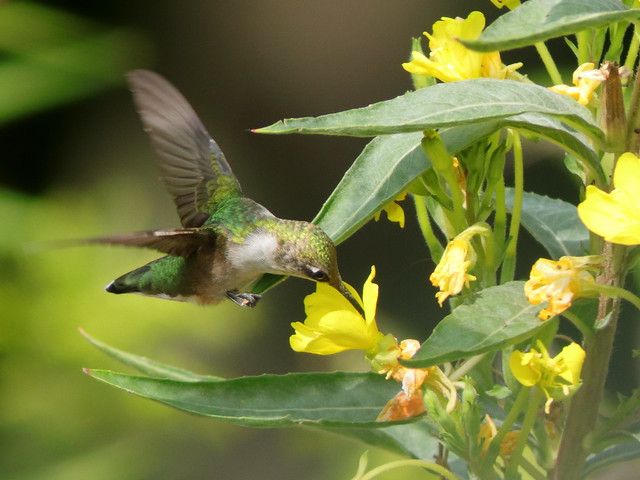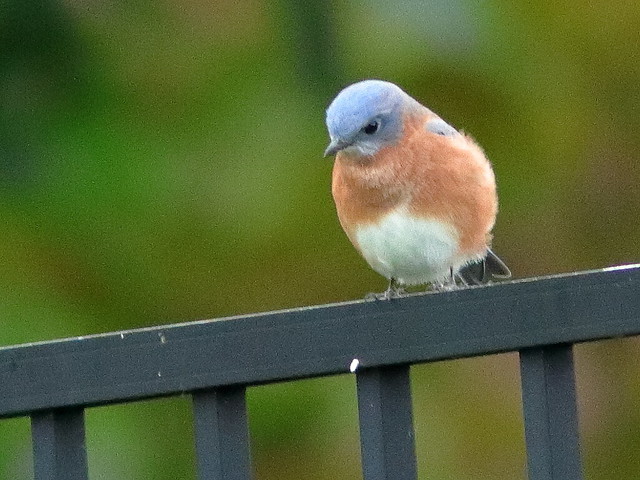Autumn has settled in quickly here in central Connecticut, with temperatures dropping even into the low 40s° F ( ~ 6° C) some nights. Before disappearing just a week ago, the Ruby-throated Hummingbirds became scarce. No more than one visited the feeders until the last one stopped by on September 21. This was my final encounter with one in a natural setting:
A cold front moved in from the northwest on September 22. The trees over the Loveland Preserve are showing a blush of yellow:
Yesterday morning the view of downtown Hartford, eleven miles distant, was particularly crisp. I enhanced my image by layering three exposures to create an HDR effect in COREL PaintShop Pro:
Small flocks of Eastern Bluebirds have been foraging for berries and insects. This male posed nicely on the fence rail:
Another bluebird was suddenly visited by two other common species, a House Finch and an Eastern Phoebe:
The phoebes are finding fewer flying insects. They and the bluebirds are eating berries. Here, a phoebe has plucked the blueberry-like fruit of the Virginia Creeper:
The Chipping Sparrows have molted out of their distinctive breeding plumage into a more subdued pattern.
Back on April 17:
Now, on September 25:
There was much action at the seed feeder, which will soon increase with the arrival of winter residents. So as not to attract bears, we bring in the feeders each night. Here, a male House Finch, a White-breasted Nuthatch and a Black-capped Chickadee gather to feast:
A highlight was the appearance of a wandering winter visitor which breeds in northern Connecticut and over northern New England and Canada, but rarely strays into our area before October or November. It was a female Purple Finch. So far this month I have seen and photographed, possibly this same one, on three separate days:
While it is similar to the House Finch, the Purple Finch is bulkier and has a proportionally larger head and a distinctive face pattern. The upper portion of the beak (culmen) of this House Finch is noticeably more curved.:
We have had golden or amber sunsets this past week. We were accustomed to seeing bright red ones all summer. There is maybe a scientific reason for this, as the sun's rays must pierce more of the earth's atmosphere in the colder months-- are the warmer colors filtered out, or are these just random events?
September 25:
September 27:
I try to find reflections, especially along Diamond Lake, but the best I could do this week was this incidental capture of my distorted face and iPhone as I photographed mugs which celebrate the Irish surnames of my and MaryLou's grandmothers:
= = = = = = = = = = = = = = =
My Corner of the World
________________________________________________
Please visit the links to all these posts to see some excellent photos on display
________________________________________________



















once again a bunch of beautiful pictures
ReplyDeleteGorgeous skies. I need to Google hummingbirds to find out where they go in the winter. They seem too small to migrate, but they do seem to disappear when the weather turns cold.
ReplyDeleteGreat skies.
ReplyDeleteThe seasons are changing and I love how you are right on top of it.
ReplyDeleteHello :=)
ReplyDeleteLovely post with many beautiful birds I never see where I live. The pretty phoebes and bluebirds are my favourites. Beautiful sky shots too!
This is one of the nicest high rise views I have seen in a long time! The Eastern bluebirds are so cute. Sorry you couldn't get any reflections, and thanks for coming by my blog this week, since my presence at my blog for the last weeks has been erratic:) Have a great weekend, Ken.
ReplyDeleteWe have a woodpecker pecking at our house. Any ideas? I love the image of Hartford, CT. Been there many times. The skies posted on different September days are awesome! I am so impressed with the bird pictures you post. I have learned so much from your blog. Thank you.
ReplyDeleteThree habits of woodpeckers can cause a nuisance. Woodpeckers DRUM on hollow logs and drain pipes because of the resonance. They DRILL rather silently in search of food. They CHISEL quietly when excavating a nest. Drumming usually does not harm the surface, but drilling and excavating does.
DeleteThere are electronic ultrasonic pest repellants said to work with rodents and birds such a pigeons, but the reviews are not very positive for woodpeckers.
Reflecting tape may be unsightly but works best if there is a breeze. Amazon has such a product here: De-Bird Scare Tape - Reflective Tape Outdoor to Keep Away Woodpeckers... $11.99. Read those reviews-- they are all over the lot but mostly positive except for the aesthetics.
When we lived in New Mexico a woodpecker (flicker) made a hole in the exterior siding on back side of our neighbor's house. I suggested they cover it with a flicker-size bird nest box. To my surprise the box was inhabited by American Kestrels and they raised families there for several years. Those little falcons certainly kept the woodpeckers away!
Love the photos nice post it's cole in London but not that cold yet :-)
DeleteHave an autumnictastic week 👍
Those top two pics are really great. I can see why they made you happy. Thanks for joining in at #OneSmallThing
ReplyDeleteThe Hartford skyline and river front have changed so much since I've been there that I don't know if I would recognize it. The purple finches always confuse me. Do the phoebes stay there all winter? If so, care for mine well. I miss their song.
ReplyDeleteAndree, the Eastern Phoebe is migratory. Its diet consists mostly of insects, but they eat fruit and turn to it when insects become scarce. They migrate north very early in the spring, well ahead of many other land birds, and remain in the north much later as well. Small numbers of them may persist all year round, especially in coastal areas of the northeastern States including Connecticut, but the vast majority spend the dead of winter in the southeastern US and northeastern Mexico.
DeleteA rich post, great images.
ReplyDeleteA wonderful series of photos. Although it is goodbye to the hummingbirds for a few months, you stillhave much to admire on your feeders. Love the sunsets.
ReplyDeleteLoving your "fall collection", Ken! Especially since they will soon be appearing at OUR feeders down here!
ReplyDeleteGotta go finish post-storm cleanup so the birds can find the feeders.
All good locally.
It sure is fun to watch the feeders when the seasons are changing. You just never know who will show up! Love the hummer and yellow flower! You take the best photos. We hiked this morning after being inside all week. No damage here but we had wind and rain. Take care, Diane
ReplyDeleteHow beautiful these bird captures are.
ReplyDeleteWorth a Thousand Words
Coming back from Ireland a couple months ago, I like seeing your Irish mugs! The bluebirds are a favorite today. You have bears? Oh my.
ReplyDeleteEnjoy the week ahead & thanks for linking in this week!
Fascinating photos, as usual! I always enjoy your lovely birds and creatures and fun reflection :)
ReplyDeleteYour hummingbird images are wonderful!
ReplyDeleteHello ken,
ReplyDeleteI love those mugs, very cool! Great captures of your yard birds. The hummer and blue birds are my favorites. Pretty captures of the Purple Finch. Sorry, I was away for a week and I am late visiting. Thank you for linking up and sharing your post. Take care, have a happy new week ! PS, thanks for leaving me a comment.
Amazing bird life
ReplyDeleteWoodpeckers are my special friends 😀 Thank you for sharing
ReplyDeleteI always find great shots at your blog! Thank you for sharing them at https://image-in-ing.blogspot.com/2022/10/bedtime-story.html, Ken! And have a wonderful week!
ReplyDelete